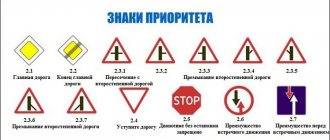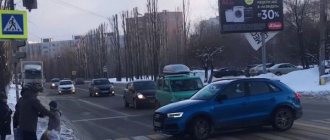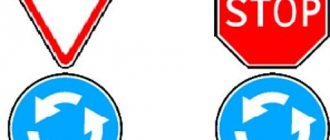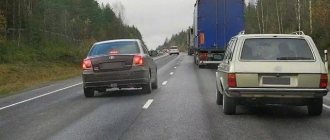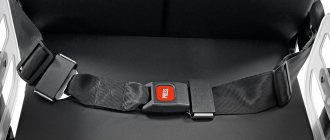| Essence: Warning road sign 1.22 Pedestrian crossing informs drivers when approaching a pedestrian crossing marked with blue signs or zebra crossings. Links to sources and paragraphs of the Traffic Regulations 2020, Code of Administrative Offenses: Traffic Rules of the Russian Federation, Appendix 1, Section 1 Warning road signs Text of the Traffic Regulations 2020: Warning road sign 1.22 Pedestrian crossing in Appendix 1 to the Traffic Regulations |
Legislation
With the advent of cars on our roads, the need for traffic control signs arose. Today, our children, even in kindergarten, begin to learn signs and traffic lights.
Road signs are an information board that helps pedestrians safely cross the roadway.
According to the law, they are divided into several types depending on functionality, and are clearly numbered:
- priority, indicating the priority of one road over another (all numbered 2);
- prohibitive, designed to restrict movement, mostly round in shape with a red border (number 3);
- warning, carrying certain information to drivers and pedestrians, they have a triangular shape with a red border (number 1);
- service, they are indispensable outside the city on the highways (number 7);
- prescriptive (number 4), having a round shape with a blue background and a white pattern;
- signs of special regulations indicating the direction of movements, turns, places to stop public transport, and so on (number 5);
- informational, square or rectangular, with a blue, less often yellow and green background (number 6);
- additional, mostly white with a black picture or indicator (number 8).
There are eight categories in total. Not all of these types are necessary for a pedestrian to know, however, there is an absolute minimum required for citizens of any age.
Some signs are typical for urban areas, while others are found only on highways outside populated areas. From time to time, changes are made to traffic rules, so we will present information that is relevant at the moment.
All about the road sign “Pedestrian crossing”
I understand that it is easier for some to cross the road in the wrong place and risk their own health, since passing cars may simply not notice you or not have time to brake. But there are traffic rules and there is a special pedestrian crossing sign.
It would seem that since this is a warning sign for pedestrians, they should be aware of it. But no, all road users must know this road sign. Even children learn it in the form of games during school lessons. This is important for their safety. Just look at the photo and you will immediately understand what we are talking about.
Important Features
When there is a traffic light in front of a pedestrian crossing, there are no problems with how and when to cross the road.
However, there are certain rules for installing this sign and several varieties. For example, sign 5.19 is placed at an uncontrolled intersection where the flow of cars is insignificant. Sometimes the sign is complemented by a traffic light that simply flashes orange or is turned off completely.
Since 2010, new rules have come into force, according to which the sign's coverage area at each pedestrian crossing must meet some additional requirements:
- signs must be supplemented with clear light animation;
- The stripes of such an “animal” called a zebra are painted white and complemented with orange;
- in some cases there may be noise bands;
- Speed bumps are placed at a distance from the signs;
- the sign is in a yellow frame with a reflective element - this is a special sign on a yellow background with a fluorescent coating that glows at night from car headlights;
- yellow flashing lights are now mandatory;
- at least one speed bump is installed in front of crossings for pedestrian traffic participants;
- Bright lighting is provided in the transition area.
If this section is of a regulated type, then the installation of a working traffic light is mandatory.
Even the sign itself can be LED. But the traffic rules do not say anything about this point, since the technology is modern, and the list of rules is far from new. But everything has its time.
Coverage area
We strongly advise you to buy yourself a traffic rules book and gradually learn what signs mean what. This will be useful to you as a pedestrian and as a future driver. As a rule, people without cars rarely study the rules of the road, but actively blame drivers for illiteracy. It's a shame, to be honest. I’m telling you this as an experienced motorist.
If you come across a pedestrian zone without a sign, then this is a clear violation. Either they didn’t finish, or the sign was stolen, or maybe the workers even thought that this was normal.
In any case, all dimensions, designations, coloring, zebra crossing and other nuances of the pedestrian crossing are regulated by GOST. Therefore, in every locality and on any section of the road they are required to follow state standards.
The same applies to the installation of signs for a special pedestrian crossing. There are two of them. Moreover, they are registered as 5.19.1 and 5.19.2. What's the difference between them? A different picture. In the first case (5.19.
1) the pedestrian moves from right to left, and in the second (5.19.2) vice versa, that is, from left to right. They are installed on the appropriate side of the road to show the direction of pedestrian movement in this area.
Now about the coverage area.
- The range of the sign is limited by the distance between two oppositely located signs. If you noticed, the pointers are not strictly opposite each other, but with an offset. It is this distance that visually forms a rectangle, which is the boundaries of the zone;
- This principle applies if there is no zebra. The presence of a zebra crossing suggests that the area is limited by this marking;
- Do not try to blame the driver for anything if you crossed the road in the area of the sign, but at the same time went outside the zone. Drivers are not fined for this, but a pedestrian is considered a violator;
- It is prohibited to stand or stop within the area of the sign and within a range of 5 meters on each side. So, dear drivers, respect yourself and pedestrians.
Actions of traffic participants
Each road user has their own rights and responsibilities. They must be adhered to in order to prevent emergencies, accidents, collisions with pedestrians, etc.
The visual picture used in schools for children allows them to understand why it is important to respect each other and how to act on one side or another.
The following rules apply to people traveling on foot:
- do not cross the road in unauthorized or undesignated places;
- go strictly to the green light of the traffic light;
- look left and right before starting to move;
- do not run when the green light is flashing;
- Don’t go too slowly (let’s respect drivers too) if there is no reason to move that way.
Now as for motorists.
- The most important rule is to let people pass who are walking or have begun to move along the crossing;
- Slow down or stop in front of such areas;
- Avoid driving through red and orange lights as people may have already started moving;
- Drivers are not allowed to turn around or reverse;
- It is strictly forbidden to make overtaking maneuvers if people are walking there (by jumping out from behind another car, you can hit a person);
- Stand and park within the sign's coverage area plus 5 meters in each direction.
Alas, even knowing all the rules sometimes cannot protect you from accidental collisions and collisions. The driver must be prepared for the fact that pedestrians will still break the rules, run out on red lights, or run across the road in the wrong place. Moreover, it is usually difficult for the driver himself to prove that it is not he, but the pedestrian, who is at fault.
Underground and overground passages
Also a pedestrian crossing, which runs underground and usually above a busy road. The presence of such passages, in front of which there is a sign with a picture of a person walking along the steps, significantly increases the level of safety.
The same can be said about overpasses intended for pedestrians. They are usually installed above railway tracks.
Such transitions appeared during the USSR. They were used to connect and allow people to move more safely. Agree, it’s easier to walk 10-20 meters underground than to cross a road where several dozen cars pass per second.
Alas, over time, transitions have become selling points. Yes, sometimes you can buy something interesting there. But still, the main task is to ensure the comfort and safety of pedestrians. Signs of this type are regulated by GOST. The above-ground sign is designated 6.7, and the underground pedestrian sign is numbered 6.6.
Thank you for reading us, subscribing, commenting on our articles and inviting your friends to discuss!
Source: https://pricep-vlg.ru/pdd/znak-peshehodnyj-perehod/
Kinds
A road sign is made in such a way as to clearly convey certain information to a person. The image on it is made in such a way that drivers and pedestrians can see it from a distance, even at night. It's quite difficult not to notice him.
Let's talk about what signs every pedestrian should know:
| Number | Image | Name | What does it mean |
| 5.19.1 and 5.19.2 | Crosswalk | Can be facing left or right. Refers to signs of special regulations. Can be installed even where there are no road markings | |
| 1.23 | Children | Warns drivers that this section of the roadway is adjacent to children's institutions (schools, health camps, etc.) | |
| 3.10 | No Pedestrians | Valid until the start of the next intersection and applies only to one side of the road, the one on which it is located | |
| 5.33 | Pedestrian zone | Designates a section of a road or area where the free movement of pedestrians and, in some cases, cyclists is permitted | |
| 5.34 | End of the pedestrian zone | End of the free pedestrian movement zone | |
| 6.6 | Underground pedestrian crossing | At this location there is a passage that allows you to cross the road underground. | |
| 6.7 | Overhead pedestrian crossing | Indicates the presence of an elevated path to cross a section of road | |
| 5.3 | Road for cars | Pedestrians are prohibited from walking on the road | |
| 5.16 | Bus (trolleybus) stop location | Even if the stop area is not fenced off in any way, or there is no place to wait for public transport (which is typical for the suburbs), you can wait for the bus right at the sign | |
| 5.17 | Tram stop location | Indicates a public transport stop | |
| 5.18 | Taxi stop location | This sign makes it easy to see where taxis stop. | |
| 4.5.2 | Pedestrian bike path | This area combines pedestrian and bicycle traffic. Its end is indicated by the same sign, but with a red line crossing out the picture | |
| 1.8 | Traffic light regulation | Warns drivers that a pedestrian crossing or intersection is nearby. If a pedestrian notices the sign, he will be informed that it is safe to cross the road 50-100 meters (for populated areas) or 100-300 meters |
This is the minimum number of signs that a pedestrian must recognize. Simple pictures make it easy for even a child to understand the essence of what is indicated. The color scheme is chosen in such a way that a person clearly understands whether the sign prohibits or allows crossing the road.
Service marks
These are traffic signs that help pedestrians (photo below). Thanks to the signs from this group, you can easily find a first aid station, a hospital, or a gas station. The “Car Maintenance” sign comes to the aid of drivers. Such a sign can be installed in front of the service station. Usually the sign indicates how many meters later the desired object can be found.
View gallery
Service signs also include signs such as “Drinking water”, “Food point”, “Hotel or motel”, “Camping”, “Recreation place”. All these signs do not affect road safety, but help drivers and passengers find their way faster.
The “Road Patrol Service Post” sign is very important for drivers. It informs drivers that there are traffic police officers in the immediate vicinity who will be able to provide assistance on the road. Some drivers, on the contrary, try to avoid meeting the patrol. Therefore, when they see such a sign, they turn onto another road.
Responsibility for violation
Among all the means of regulation on roads for pedestrians, the most significant is the traffic light. With his help we cross the road every day. But it does not always occur, so you should not ignore traffic signs for pedestrians.
In addition, citizens are held accountable for violating traffic rules.
| 30-32% | committed with the participation of pedestrians |
| 13-15% | committed through the fault of a pedestrian |
The numbers are quite serious when you consider how many citizens die every year when crossing the road in the wrong place. Large populated areas and highways are places of increased danger where traffic rules should be followed exclusively.
On the one hand, fines have been increased for drivers who ignore pedestrian crossing signs and do not stop to let a person pass. On the other hand, changes have been made to the Code of Administrative Offenses.
For pedestrians who violate the rules, Articles 12.29, Part 1 and 12.30, Parts 1 and 2 are provided. Depending on the situation, a citizen may face:
| fine of 500 rubles | if the act did not entail any consequences |
| fine of 1000 rubles | if crossing the road in the wrong place resulted in interference for the vehicle |
| fine from 1000 to 1500 rubles | if, as a result, slight or moderate harm to the health of any person was caused |
A citizen will not get off with a fine if, as a result of such a maneuver, an emergency situation was created that resulted in serious harm and death.
In this case, the person faces criminal liability under Article 268 of the Criminal Code of the Russian Federation. The punishment depends on the specific situation. Maximum - imprisonment for a term of up to 7 years.
Information signs
The main road signs for pedestrians and their meaning will be described below. On busy sections of the route there must be the possibility of safe passage. Where there is a lot of pedestrian traffic, a special ground or underground passage can be installed. The corresponding signs will notify you about this. Such crossings help to significantly save time and do not restrict traffic. It is worth considering that where there is an overground or underground passage, cars move at increased speed. Therefore, crossing the road not according to the rules is very dangerous.
View gallery
Signs indicating preliminary directions make life much easier for passengers and car owners who find themselves in a foreign city. Thanks to them, you can easily find the desired street or locality without a navigator. Signs of this type indicate not only the direction to follow, but also how many kilometers you still have to travel. Prohibition signs may also be placed here.
Information signs also include signs with the name of a settlement, which are placed on its outskirts. Such traffic signs for pedestrians with names do not affect traffic safety in any way. However, they allow you not to get lost and significantly save time.
Informational signs include a sign indicating a parking space. It looks like a blue square with a white “P” in the middle. A blue circle with a red border and a red line through it means “No Parking.”
Is it possible to challenge
Pedestrians often violate traffic rules by crossing the road in the wrong place. Even if the pedestrian crossing is installed ten meters away from them. The reasons are banal:
- rush;
- inattention.
When an inspector records a violation of traffic rules by a pedestrian, it is almost impossible to challenge penalties. A protocol will be drawn up against the citizen, as well as against the driver.
You can agree with the inspector on the spot and ask him not to punish you, but to limit himself to a warning.
However, difficult cases on the roads are not uncommon. Please note that any disputes must be resolved in court, supporting your version with evidence. In practice, this can be done if you enlist the support of witnesses and provide video from the scene of the incident.
It is necessary to cross the road only in designated places. These rules are dictated by safety considerations. Additionally, small pedestrians should be trained.
Requirements for installing signs and their coverage area
The simplest option for a pedestrian crossing is an unregulated one. As a rule, such intersections were marked only by a zebra crossing and signs installed on both sides of the road.
However, after 2010, some changes appeared in the rules and now on busy roads a pedestrian crossing should look like this:
- So-called “speed bumps” have become widespread, forcing the driver to slow down in front of a dangerous area.
- Additional lighting is installed to ensure safe passage at night.
- For wide streets, a duplicate sign must be placed above the roadway.
- To further attract attention, flashing yellow lights are used.
- The sign itself has also undergone slight changes; now it has a yellow-green reflective outline.
- Instead of speed bumps, it is important to use so-called “noise stripes” that attract the driver’s attention while driving.
- The usual “Zebra” is now applied in combination with yellow stripes.
- Signs indicating the presence of a pedestrian crossing are installed on both sides of the street.
- A pedestrian zone is considered to be the distance from one sign to another, and if a zebra crossing is painted on the asphalt, then its width is considered a pedestrian zone.
Video on the topic:
Attention!
- Due to frequent changes in legislation, information sometimes becomes outdated faster than we can update it on the website.
- All cases are very individual and depend on many factors. Basic information does not guarantee a solution to your specific problems.
That's why FREE expert consultants work for you around the clock!
- via the form (below), or via online chat
- Call the hotline:
- 8 (800) 700 95 53
APPLICATIONS AND CALLS ARE ACCEPTED 24/7 and 7 days a week.
Traffic rules
Which rule reflects
The driver is obliged to give way to a pedestrian crossing the road at a marked crossing
When driving a car through a ground-type pedestrian crossing, each driver must strictly adhere to traffic rules. Moreover, this requirement applies to all vehicles without exception.
The sign indicates to drivers that they are starting to move along an important section of the road. People move around in this part of the roadway.
This sign requires all drivers to give way to pedestrians crossing the street. At the same time, the presence of a pedestrian crossing gives each pedestrian some advantage over a car.
When approaching a crossing, the driver of any vehicle must stop or significantly reduce speed. Thus, it provides the opportunity for all pedestrians to safely cross the roadway.
According to the new rules, a section of tram tracks can also be a pedestrian crossing. Markings are applied on it and road signs are installed that determine the crossing location. As a result, not only car drivers, but also car drivers in such areas must let people cross the road.
Traffic rules at pedestrian crossings prohibit the following actions by drivers:
- perform any types of turns;
- move in reverse;
- overtake if there are people at the crossing;
- park directly at the crossing;
- cross a zebra crossing;
- park in the area covered by 5.19.
Overhead passage
In areas of active traffic in large cities, special structures are built to help people get to the other side of the street. Such overpasses are called intrastreet corridors. They are relevant not only for wide roads with several lanes in different directions, but also for the safe crossing of railway sections. Such add-ons have certain advantages:
- there is no need for round-the-clock lighting of the allocated area;
- there is no need to affect underground communications;
- the structures have a more affordable price tag than their underground counterparts;
- Their safety is higher than that of ground-based symbols.
